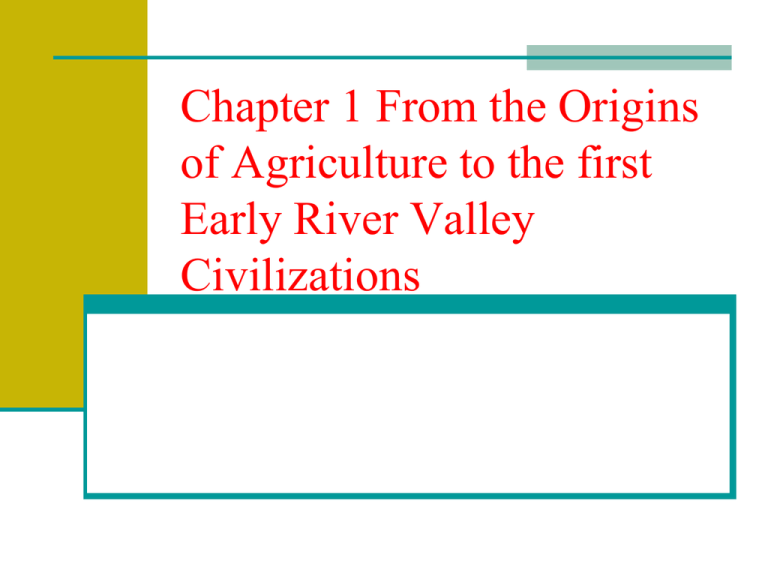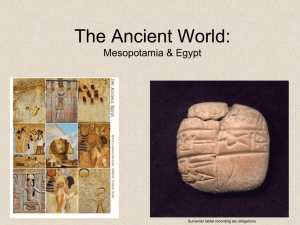
Chapter 1 From the Origins
of Agriculture to the first
Early River Valley
Civilizations
Before Civilization
Stone Age- 2 million to 4 thousand years ago
Stone age is subdivided into the Paleolithic
age (old stone age to 10,000 years ago) and
the Neolithic Age (New Stone Age)
Stone tools are developed in the Paleolithic
Age
Chauvet Cave
On December 18, 1994, this cave in southern France was discovered by JeanMarie Chauvet, a French official. It contains the oldest and best preserved
prehistoric cave paintings; more than three hundred paintings were found of
animals that inhabited the Stone Age world, including panthers, cave bears,
and mammoths. This black-painted panel in the Chauvet Cave shows horses,
rhinoceroses, and wild oxen. (Jean Clottes/Ministere de la Culture)
Cave Art (click on video)
Fossilized footprints
Fossilized footprints
Archaeologist Mary Leakey
(shown at top of photo) found
these remarkable footprints of a
hominid adult and child at Laetoli,
Tanzania. The pair had walked
through fresh volcanic ash that
solidified after being buried by a
new volcanic eruption. Dated at
3.5 million years old, the
footprints are the oldest evidence
of bipedalism yet found.
(SPL/Photo Researchers, Inc.)
Copyright © Houghton Mifflin Company. All rights reserved.
The Agricultural Revolutions
The first stage of the long process of
domestication of plants was semicultivation
pg. 8
The next stage was the use of fire
The transition to agriculture took place first
and is best documented in the Middle East
The environments in which agriculture
developed dictated the choice of crops
Domestication of animals proceeded at the same
time as domestication of plants
As with plants, domestication of animals occurred
independently in various parts of the world
Helocene Period 9000 B.C.E. - when most historians
agree that a global warming made people transition
from hunter gathering lifestyles to agricultural or
pastoralist lifestyles.
This change took place most likely due to a reduction
in the supply of game and wild food plants
The agricultural revolution increased population from
10 million in 5000 B.C.E to between 50 and 100
million in 1000 B.C.E
Centers of Plant and Animal Domestication
Many different parts of the world made original contributions to domestication
during the agricultural revolutions that began about 10,000 years ago. Later
interactions helped spread these domesticated animals and plants to new
locations. In lands less suitable for crop cultivation, pastoralism and hunting
predominated. (Copyright (c) Houghton Mifflin Company. All Rights Reserved.)
Life in Neolithic Communities
Early
foodproducing
societies
used
megaliths
Pg 12
Early Towns and Specialists
Most people in early food-producing societies
lived in villages
Larger Towns would also develop in Neolithic
times
The two best-known examples of the remains
of Neolithic towns are at Jericho and Çatal
Hüyük.
Jericho, on the west bank of the Jordan River,
was a walled town with mud-brick structures
and dates back to 8000 B.C.E.
Jericho
Catal Huyuk
Çatal Hüyük, in central
Anatolia, dates to
7000–5000 b.c.e.
Çatal Hüyük was a
center for the trade in
obsidian.
Catal Huyuk
The art of Çatal Hüyük reflects a continued
fascination with hunting, but the remains indicate
that agriculture was the mainstay of the economy.
Catal Huyuk
Catal Huyuk
Neolithic goddess
Neolithic goddess
Many versions of a wellnourished pregnant female
figure were found in the
Neolithic ruins of Catal
Huyuk, a large town in central
Anatolia (modern Turkey).
Here she is supported by twin
leopards whose tails curve
over her shoulders. To those
who inhabited the city this
figure likely represented
fertility and power over
nature. (C.M. Dixon)
Copyright © Houghton Mifflin Company. All rights reserved.
Mesopotamia
Mesopotamia is the alluvial plain area
alongside and between the Tigris and
Euphrates Rivers.
little rainfall
warm climate and good soil.
The earliest people of Mesopotamia were the
Sumerians Approx. 5000 B.C.E
A Sumerian cuneiform tablet from the city of
Lagash, 2112-2004 B.C., from the Ur III period.
This tablet contains calculations of the area of
fields for the town of Lagash.
Early Mesopotamian society was a society of villages
and cities linked together in a system of mutual
interdependence
City States Developed
Larger Territorial states would develop
Akkadian state founded by Sargon of Akkad in 2350
B.C.E
Ur from 2112-2004 B.C.E
“Old Babylonian” state founded by Hammurabi
Hammurabi’s Code- The first great laws of early
Mesopotamian society
Akkadian bronze of Sargon
Akkadian bronze of Sargon
This stern-faced, life-size castbronze head, with its stylized
ringleted beard and carefully
arranged hair, shows
Mesopotamian craftsmanship
at its finest. It is thought to be
either Sargon (2371-2316
B.C.E.) or Naram-sin (ca.
2250-2220 B.C.E.). (Claus
Hansmann)
Copyright © Houghton Mifflin Company. All rights reserved.
Law Code of Hammurabi
Law Code of Hammurabi
The principal collection of
laws in ancient Mesopotamia
was the code of Hammurabi,
the Babylonian ruler.
Unearthed by French
archaeologists in 1901-1902,
this stele contained the code,
which Hammurabi claimed
rested on the authority of the
gods. (Hirmer Verlag Munich)
Copyright © Houghton Mifflin Company. All rights reserved.
Overview of Ur
Overview of Ur
This photograph gives a good idea of the size and complexity
of Ur, one of the most powerful cities in Mesopotamia (present
Iraq). In the lower right-hand corner stands the massive
ziggurat of Umammu. (Georg Gerster/Photo
Researchers, Inc.)
Copyright © Houghton Mifflin Company. All rights reserved.
Saharan rock art
Saharan rock art
An unknown artist painted the dynamic scene of giraffes on a
Saharan rock in what is now Libya in 5000 B.C.E. This was
from a rainy era when hunters could view majestic herds of
game. (Robert Estall Photography)
Copyright © Houghton Mifflin Company. All rights reserved.
Mesopotamia
Resources
Territorial Expansion
Long Distance
Trade
Mesopotamian Society
Kings, Priests controlled wealth
Three Classes of people
1. Free landowning people
2. Dependent farmers and artisans
3. Slaves (Prisoners of War)
Development of Writing
Development of agriculture brought about a
decline in the status of women
Men did the value-producing work of plowing
and irrigation
Women had no political role
They could own property, control their dowry,
and engage in trade.
Women’s social status would continue to
decline with the rise of urban merchant class
Mesopotamian Religion
Anthropomorphic
Deities
(Human Characteristics
For Animals or Inanimate
Things)
Tutelary Gods
(Gods that protect
Each city)
(click on video)
Temples (Ziggurat)
Priesthood served
the Gods
Common people
possibly had
beliefs in magic
Technology and science
Cuneiform-
evolved from
the use of
pictures to
represent the
sounds of
words or
parts of
words.
(click on video)
Egypt
The Land of Egypt: “Gift of the Nile”
The land of Egypt is defined by the Nile River,
the narrow green strip of arable land on either
side of its banks, and the fertile Nile delta
area.
The rest of the country is barren desert, the
unfriendly “Red Land” that contrasted with the
“Black Land,” which was home to the vast
majority of the Egyptian population
Egypt was traditionally
divided into two areas:
Upper Egypt, along the
southern part of the Nile
as far south as the First
Cataract, and Lower
Egypt, the northern
delta area.
The climate was good
for agriculture, but with
little or no rainfall,
farmers had to depend
on the river for
irrigation.
The Nile floods regularly and at the right time
of year, leaving a rich and easily worked
deposit of silt.
Egyptian agriculture depended upon the
floods, and crops could be adversely affected
if the floods were too high or not high enough.
Generally speaking, however, the floods were
regular, and this inspired the Egyptians to
view the universe as a regular and orderly
place.
The Nile River Video
Egypt’s other natural resources included
reeds (such as papyrus for writing), wild
animals, birds and fish, plentiful building
stone and clay, and access to copper and
turquoise from the desert and gold from
Nubia.
Divine Kingship
Egypt’s political organization evolved from a
pattern of small states ruled by local kings to
the emergence of a large, unified Egyptian
state around 3100 b.c.e.
Historians organize Egyptian history into a
series of thirty dynasties falling into three
longer periods: the Old, Middle, and New
Kingdoms. These three periods were divided
by periods of political fragmentation and
chaos.
Kings known as pharaohs dominated the
Egyptian state.
The pharaohs were regarded as gods come
to earth to ensure the welfare and prosperity
of the people.
The death of a pharaoh was thought to be the
beginning of his journey back to the land of
the gods.
Funeral rites and proper preservation of the
body were therefore of tremendous
importance.
Early pharaohs were buried in flat-topped
rectangular tombs.
Stepped pyramid tombs appeared about
2630 b.c.e. and smooth-sided pyramids a bit
later.
Bodies of Water
Black Sea
Dardanelles Strait
Atlantic
Ocean
Tigris
Euphrates
River
Jordan River
River
Suez Canal
Nile
River
Strait of
Hormuz
Gulf
of
Oman
Arabian
Sea
Gulf of Aden
Indian
Ocean
The Mighty Nile River:
“Longest River in the World”
The Tigris & Euphrates
River System
Mesopotamia:
”Land Between the Two
Rivers”
Marsh Arabs, So.
Iraq
Egypt: The “Gift of the Nile”
Nile Delta
Annual Nile Flooding
95% of the Egyptian
people live on 5% of
the land!
Cairo, Egypt:
Most Populated City in the Middle East
17,000,000+
People!
Middle East: Population Density
Mountains & Plateaus
Caucasus
Mts.
Anatolian
Plateau
Atlas Mts.
Iranian
Zagros Plateau
Mts.
The Fertile Crescent
Deserts
Libyan Desert
Sahara Desert
Negev
Sinai
Desert
Desert
Arabian
Desert Rub
al-Khali
Fertile Crescent


